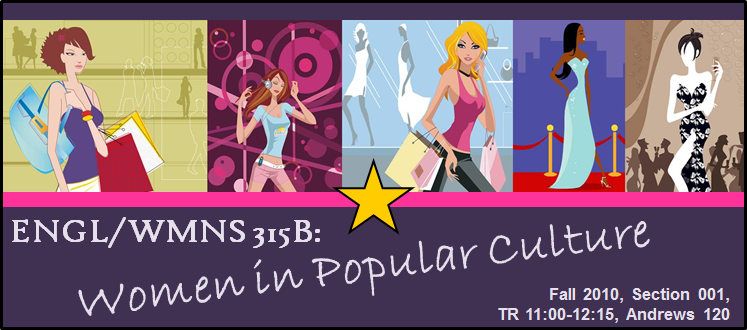 Taught face-to-face and online sections.
Taught face-to-face and online sections.
Course Description & Philosophy:
In this course, we ask several questions: What stories does our popular entertainment and culture tell about women? About women’s sexuality? About feminism? About race, class, age, (dis)ability, or other social locations? What can we learn from these stories? Which messages are positive and which are problematic? How does our society tell stories about what it means to be a girl/woman (and, as a consequence, what it means to be a boy/man) and about how one “does” gender?
We will examine various representations and constructions of women in popular culture and different media. We will investigate women’s images, roles, perspectives, and contributions to aspects of popular culture ranging from American popular music to romance stories to television to feminism. As an English course, we will “read” the stories inherent in cultural artifacts and situations to gain a greater understanding of how society views/creates women, how women understand themselves and each other, and how women can and do contribute to society’s popular conceptualization of women, both positively and negatively.
Philosophically, this course is designed to function from a feminist teaching perspective, which means that my role as an instructor is to guide and facilitate the class; your role as a member of our classroom community includes active participation and engagement (do the readings, talk in class, etc.). I expect that you will learn from me and from one another and I will learn from you. I look forward to our intellectual journey this semester.
Course Objectives:
- To examine representations of women in various genres of (primarily American) popular culture including literature, music, film/television, blogs, and print media
- To learn about and practice the use of gender as an analytical lens
- To practice popular culture critique through written analysis of course-related texts and/or cultural artifacts
- To practice oral communication skills through in-class presentation of individually researched material
Texts:
- Confessions of a Video Vixen by Karrine Steffans; ISBN: 978-0060892487
- Pride and Prejudice by Jane Austen, ISBN: 978-0141439518 (any edition is acceptable)
- Dirty Girls Social Club by Alisa Valdes-Rodriguez; ISBN: 978-0312313821
- One woman’s magazine of your choosing
- Selected articles available on Blackboard
Bibliography of articles:
- Austen, Jane and Seth-Grahame Smith. Selection. Pride and Prejudice and Zombies: The Graphic Novel. Adapted by Tony Lee. Illustrated by Cliff Richards. New York: Ballantine, 2010. [1-17]. Print.
- Baumgardner, Jennifer and Amy Richards. “A Day Without Feminism.” Manifesta: Young Women, Feminism, and the Future. New York: Farrar, Straus and Giroux, 2000. 3-9. Print.
- Bennett. Jessica. “Generation Diva: How our Obsession with Beauty is Changing Our Kids.” Newsweek. 2009. Web. 02 April 2009.
- Brumberg, Joan Jacobs. “Body Projects.” The Body Project: An Intimate History of American Girls. New York: Vintage Books, 1997. 97-130. Print.
- Burnett, Tamy. “The Other F-Word Creates Ideas in Gender Debates.” The Daily Nebraskan 8 Sept. 2010: 4. Print.
- Douglas, Susan J. “Fantasies of Power.” Enlightened Sexism: The Seductive Message that Feminism’s Work is Done. New York: Henry Holt, 2010. 1-22. Print.
- Esposito, Jennifer. “What Does Race Have to Do with Ugly Betty?: An Analysis of Privilege and Postracial(?) Representations on a Television Sitcom.” Television & New Media 10.6 (2009): 521-535. Web. Sage. 17 Aug. 2010.
- Gould, Lois. “X: A Fabulous Child’s Story.” 1978. The Gender Center, Inc. Web. 05 Jan. 2011.
- Hamilton, Laura. “Trading on Heterosexuality: College Women’s Gender Strategies and Homophobia.” Gender & Society 21.2 (2007): 145-171. Web. Sage. 05 Jan. 2011.
- Hesse-Biber, Sharlene Nagy. “Joining the Cult of Thinness.” The Cult of Thinness. 2nd ed. New York: Oxford UP. 2007. 131-151. Print.
- Jones, Liz. “What I Think About the Fashion World.” Mail Online. N.d. Web. 05 Jan. 2011.
- Katz, Jackson. “It Takes a Village to Rape a Woman.” The Macho Paradox: Why Some Men Hurt Women, and How All Men Can Help. Naperville, IL: Sourcebooks, 2006. 149-179. Print.
- “Letters and Comments.” Bitch 43 (2009): 7-8. Print.
- Levine, Elana. “Buffy and the ‘New Girl Order’: Defining Feminism and Femininity.” Undead TV: Essays on Buffy the Vampire Slayer. Eds. Elana Levine and Lisa Parks. Durham, NC: Duke UP, 2007.168-189. Print.
- Levy, Ariel. “Raunch Culture.” Female Chauvinist Pigs: Women and the Rise of Raunch Culture. New York: Free Press, 2005. 7-45. Print.
- Little, Tracy. “High School Is Hell: Metaphor Made Literal in Buffy the Vampire Slayer.” Buffy the Vampire Slayer and Philosophy: Fear and Trembling in Sunnydale. Ed. James B. South and William Irwin. New York: Open Court, 2003. 282-293. Print.
- McIntosh, Peggy. “White Privilege: Unpacking the Invisible Knapsack.” Feminist Frontiers. Ed. Verta Taylor, Nancy Whittier, and Leila J. Rupp. 8th ed. New York: McGraw Hill, 2009. 12-18. Print.
- Meade, Rebecca. “The Business of Brides.” One Perfect Day: The Selling of the American Wedding. New York: Penguin, 2007. 33-54. Print.
- Medeiros, Teresa. “My Darling Mr. Darcy: Why Is the Unattainable So Irresistible?” Flirting with Pride & Prejudice. Ed. Jennifer Cruise. Dallas: BenBella, 2005. 107-111. Print.
- Meyer, Stephanie. “Confessions.” Twilight. New York: Little, Brown, & Co., 2005. 260-285. Print.
- Pruitt, Lesley. “Real Men Kill and a Lady Never Talks Back: Gender Goes to War in Country Music.” International Journal on World Peace 24.4 (2007): 85-106.
- Roberts, Robin. “‘Justify My Love’: Music Videos and the Construction of Sexuality.” Ladies First: Women in Music Videos. Jackson: U of Mississippi P, 1996. 59-80. Print.
- Rose, Tricia. “There are Bitches and Hoes.” The Hip Hop Wars. New York: Perseus, 2008. 167-185. Print.
- Rowe, Kathleen. “Roseanne: The Unruly Woman as Domestic Goddess.” The Unruly Woman: Gender and the Genres of Laughter. Austin: U of Texas P, 1995. 50-65, 77-91. Print.
- Russ, Joanna. “What Can a Heroine Do? or Why Women Can’t Write.” 1971. Feminist Literary Theory and Criticism. Eds. Sandra M. Gilbert and Susan Gubar. New York: Norton, 2007. 200-211. Print.
- Seifert, Christine. “Bite Me! (Or Don’t).” Bitch 42 (2009). Web. 05 Jan 2011.
- Southard, Belinda A. Stillion. “Beyond the Backlash: Sex and the City and Three Feminist Struggles.” Communication Quarterly 56.2 (2008): 149-167. Web. EBSCO. 17 Aug. 2010.
- Swendson, Shanna. “The Original Chick-Lit Masterpiece.” Flirting with Pride & Prejudice. Ed. Jennifer Cruise. Dallas: BenBella, 2005. 63-69. Print.
- Watt-Evans, Lawrence. “A World at War.” Flirting with Pride & Prejudice. Ed. Jennifer Cruise. Dallas: BenBella, 2005. 27-32. Print.
- Wilson, Natalie. “Twilight Fandom: Taking a Bite of Gendered Backlash.” Seduced By Twilight. SeducedByTwilight.wordpress.com, 29 June 2010. Web. 19 Aug. 2010.


